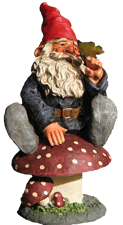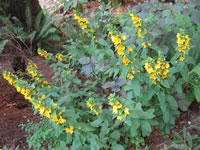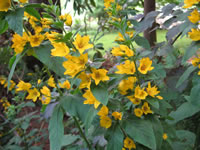How to Grow and Care for Golden Loosestrife Plants
Lysimachia punctata
          
|
 |
Golden Loosestrife is an excellent plant for growing in bog gardens or next to ponds and streams.
It should not be confused with the noxious weed called Purple Loosestrife (Lythrum),
but it can become invasive as well, spreading vigorously by
underground rhizomes if its growth is not controlled.
This 3-4 foot tall, upright perennial has whorls of light green, 3" leaves with serrated edges.
In early to mid-summer, Golden Loosestrife produce abundant spikes of
star shaped, golden yellow flowers, tinged in red at the base.
They are excellent for long lasting, cut flower bouquets.
Growing Requirements for Golden Loosestrife Plants
Golden Loosestrife are easy to grow, undemanding plants that are hardy in USDA zones 5-10. |
|
They should be grown in a site that receives full sun to partial shade,
except in hot summer regions where they will require partial to full shade.
They will tolerate drier soil and will spread more slowly if they are grown in partially shaded areas.
Golden Loosestrife thrive when they are planted in rich, slightly acidic, moisture retentive, but well-drained garden soil
that has been supplemented with compost or other organic material at planting time.
Propagating Golden Loosestrife Plants
Golden Loosestrife plants should be divided every 2 or 3 years,
in the spring or fall to control their growth.
This is the fastest method of propagating new Lysimachia plants.
They can also be propagated with root cuttings taken in the spring or summer.
Cut a healthy, fleshy section of a root into 2" segments and place them
close together in a shallow flat of potting soil before covering them with ½" of soil. Keep the soil moist until 2 or 3 leaves have developed, then they can be moved into pots or into the garden if all danger of frost has passed.
Golden Loosestrife self-seeds readily, and the seedlings are easy to transplant, but they will not bloom until their second year.
|
|
Golden Loosestrife
Lysimachia punctata
 |
 |
|
|
|
|
Search The Garden Helper:

